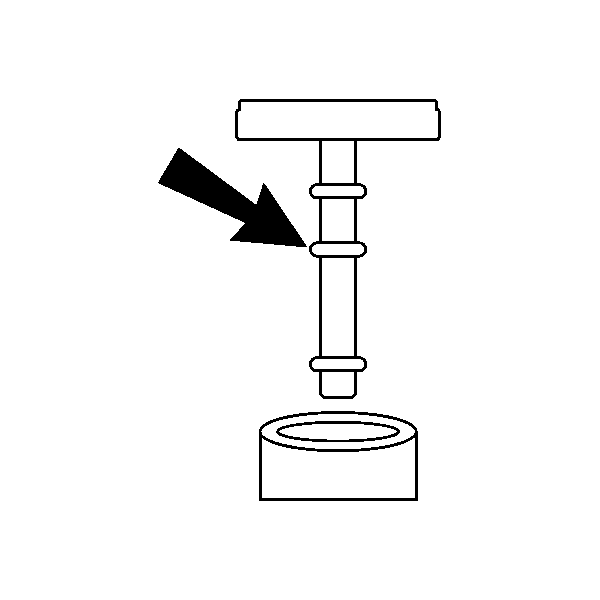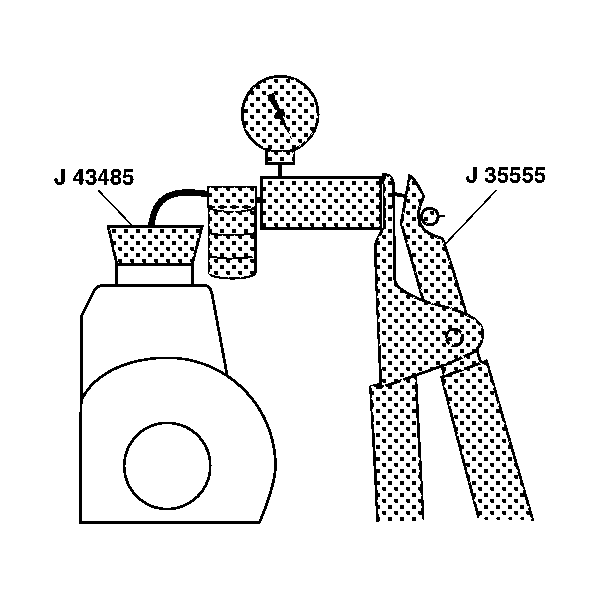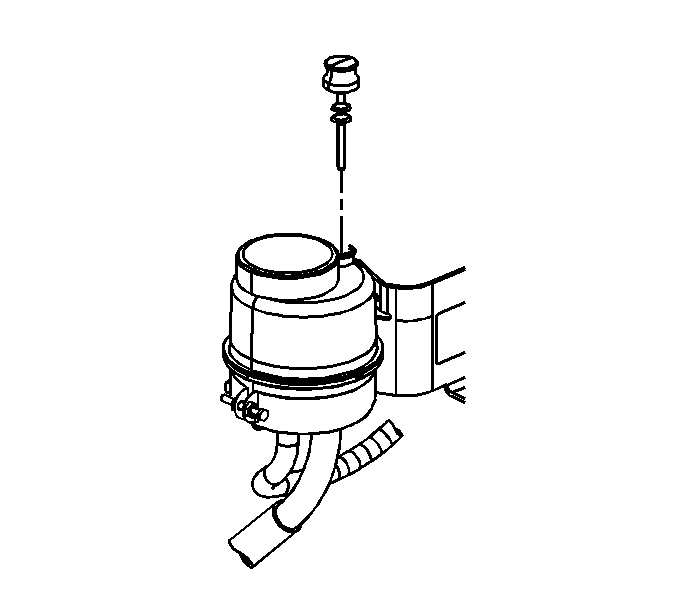Power Steering System Bleeding Vacuum
Tools Required
| • | J 44435 Power
Steering Bleeder Adapter |
Notice: If the power steering system has been serviced, an accurate fluid level
reading cannot be obtained unless air is bled from the steering system. The
air in the fluid may cause pump cavitation noise and may cause pump damage
over a period of time.
Notice: When adding fluid or making a complete fluid change, always use the
proper power steering fluid. Failure to use the proper fluid will cause hose
and seal damage and fluid leaks.
Important: Hoses touching the frame, body, or engine may cause system noise.
- Verify that the hoses do not touch any other part of the vehicle.
Important: Loose connections may not leak, but could allow air into the steering
system. Loose connections often cause air bubbles in the reservoir.
- Verify that all hose connections are tight.

Important: Maintain the fluid level throughout the bleed procedure.
- Remove the power steering reservoir cap.
Important: Use clean, new power steering fluid only, and avoid getting any dirt
or contamination in the system.
- Fill the power steering reservoir with fluid to the MAX index mark on
the reservoir.

- Attach the J 44435
to the J 35555
or equivalent.
- Place the J 44435
on or in the pump reservoir filler neck.
- Apply a vacuum of 68 kPa (20 in Hg) maximum.
- Wait 5 minutes.
Typical vacuum drop is 7-10 kPa (2-3 inches Hg).
If the vacuum does not remain steady, refer to Excessive Vacuum Drop Diagnosis
at the end of this procedure.
- Remove the J 44435
and the J 35555
.
- Reinstall the power steering reservoir cap.
- Start the engine. Allow the engine to idle.
- Turn off the engine.
- Verify the fluid level. Repeat steps 11-13 until the fluid
stabilizes.
Important: Do not turn steering wheel to lock.
- Start the engine. Allow the engine to idle.
- Turn the steering wheel 180-360 degrees in both directions
5 times.
- Switch the ignition off.
- Verify the fluid level.

- Remove the power steering
reservoir cap.

- Attach the J 44435
to the J 35555
or equivalent.
- Place the J 44435
on or in the pump reservoir filler neck.
- Apply a vacuum of 68 kPa (20 in Hg) maximum.
- Wait 5 minutes.
- Remove the J 44435
and the J 35555
.
- Verify the fluid level.

- Reinstall the pump reservoir
cap.
Excessive Vacuum Drop Diagnosis

- If the vacuum continues
to drop, remove the pressure and return hose from the pump.
- Install the plugs (1, 2) supplied with the J 44435
into the pressure and
return port.

- Attach the J 44435
to the J 35555
or equivalent.
- Place the J 44435
on or in the pump reservoir filler neck.
- Apply a vacuum of 68 kPa (20 in Hg) maximum.
- If the vacuum drops again, repair or replace the pump. If the
vacuum holds steady, continue to check the other parts of the steering system.
Important: Fluid must be free from bubbles and foam. Be aware of periodic bubbles
that indicate a loose connection or leaking O-ring seal in the return hose
or the pressure hose.
Fluid must be free from discoloration.
- Observe the fluid.
- If condition persists, inspect the following parts:
| • | The suction hose and adapters |
| • | The pressure hose and adapters |
| • | The return hose and adapters |
| • | The brake booster hose and adapters |
| • | The power steering pump and gear fittings and O-rings |
- Repeat the bleed procedure from the beginning.
- Drive the vehicle approximately 16 km (10 mi) in
order to warm the system to operating temperature. Evaluate vehicle on
a smooth flat surface.
- Verify the following conditions:
| • | There is smooth power assist. |
| • | The vehicle operates quietly. |
| • | The pump maintains the proper fluid level. |
| • | There is no leaking in the steering system. |
| • | The fluid is free of foam or discoloration. |
Power Steering System Bleeding Manual
Notice: If the power steering system has been serviced, an accurate fluid level
reading cannot be obtained unless air is bled from the steering system. The
air in the fluid may cause pump cavitation noise and may cause pump damage
over a period of time.
Notice: When adding fluid or making a complete fluid change, always use the
proper power steering fluid. Failure to use the proper fluid will cause hose
and seal damage and fluid leaks.
Important: Hoses touching the frame, body, or engine may cause system noise.
- Verify that the hoses do not touch any other part of the vehicle.
Important: Loose connections may not leak, but could allow air into the steering system. Bubbles in the reservoir could mean that the system is pulling in air and the system will not bleed.
- Verify that all hose connections are tight.

Important: Maintain the fluid level throughout the bleed procedure.
- Remove the power steering reservoir cap.
Important: Use clean, new power steering fluid only, and avoid getting dirt or contamination into the system.
- Fill the power steering reservoir with fluid to the MAX line on the reservoir.
- Turn the steering wheel to the right to gain access to the power steering gear.
- Do not turn the steering wheel during the manual bleed process.
- Make sure the wheels are blocked and the park brake is on.
- Start the vehicle and run the engine at low RPM.
- Remove the plug cap from the bleeder screw on the power steering gear.
- Open the bleeder ½-1 revolution so that air in the housing can escape.
- Do not let the reservoir run low on fluid.
- As soon as only oil runs out of the bleeder, close the bleeder.
- Top off the fluid to the MAX line on the reservoir.
- Turn the steering wheel several times, lock to lock.
- Repeat the manual bleed procedure 3-4 times, and turn off the engine 3-4 minutes between each repetition.
Notice: Refer to Fastener Notice in the Preface section.
- When finished bleeding the system torque bleed screw.
Tighten
Tighten to 27 N·m (20 lb ft).
- Drive the vehicle in order to warm the system to operating temperature. Make several turns during the drive.
- Evaluate the vehicle on a smooth, flat surface. Verify the following conditions:
| • | There is smooth power assist. |
| • | The vehicle operates quietly. |
| • | The pump maintains the proper fluid level. |
| • | There is no leaking in the steering system. |
| • | The fluid is free of foam or bubbles. |
| • | The bleeding procedure is complete. |








